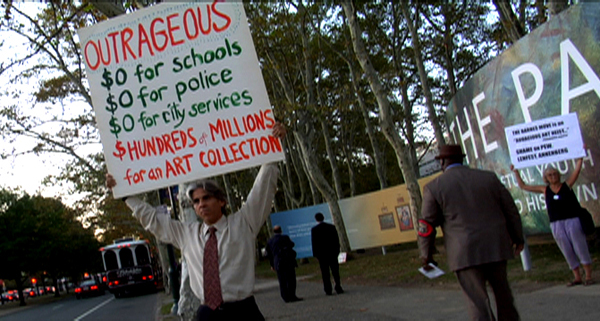 DEMONSTRATION IN FRONT OF THE NEW VENUE FOR THE BARNES COLLECTIONA history and a polemicThe Art of the Steal is a documentary that chronicles the long and dramatic struggle for control of the Barnes Foundation, a private collection of Post-Impressionist and early Modern art valued at more than $25 billion.
DEMONSTRATION IN FRONT OF THE NEW VENUE FOR THE BARNES COLLECTIONA history and a polemicThe Art of the Steal is a documentary that chronicles the long and dramatic struggle for control of the Barnes Foundation, a private collection of Post-Impressionist and early Modern art valued at more than $25 billion.--Film publicity.
Actually, it's $25-$35 billion. The value is really incalculable. Albert C. Barnes (1872-1951) was a Philadelphian of working-class origins who used his fortune from an antiseptic compound called Argyrol to collect: 181 Renoirs, 69 Cezannes, 59 Matisses (including his commissioned, unique, Art of the Dance murals), 46 Picassos, 21 Soutines, 18 Rousseaus, 16 Modiglianis, 11 Degas, 7 Van Goghs, 6 Seurats, 4 Manets and 4 Monets. And these are quality, not just quantity: they include some of the named artists' best works. For Renoir, Cezanne, and Matisse, this collection is unique, and there may be no other private collection of such work of this magnitude.
Barnes was a great collector. He was also famously cranky and opinionated. He deeply and lastingly resented the fat cats of the city of Philadelphia who mocked the work in his collection when it was first shown. He chose to keep the collection away from those Philadelphian fat cats. A friend of the philosopher and educational theorist John Dewey, he built a museum in Merion, Pennsylvania (five miles from Philadelphia) on his own land, a 12-acre Arboretum, and restricted visits, running the Foundation as a teaching institution, which was his main focus in life from the Twenties till his death in a car accident in 1951. The collection was displayed as in a house, arranged with furniture and decorations, in aesthetically pleasing (if rather overly-symmetrical) groupings, rather than in the contemporary museum's open space, white wall style.
Barnes' will specified that the collection must never be loaned out or sold. His will put Lincoln University, a small black college, in charge of the collection after his death.
For a long time the Foundation was run by a close follower of the Barnes spirit, Violette de Mazia. But after she died in 1988, gradually, and recently quite rapidly, the will has been abrogated, the trust broken. In the Nineties an ambitious man named Richard H. Glanton, who was then in charge of it, loaned the collection to various major venues, including the Musee d'Orsay in Paris, and ending, ironically, at the Philadelphia Museum of Art, ostensibly to raise money. More recently a powerful nexus of politicians (the governor and the mayor of Philadelphia), the Annenbergs, the Philidelphia Museum, and rich charitable organizations, mainly the Pew Foundation, have worked not only to get control away from Lincoln University but to move the whole collection to a new building in the city of Philadelphia, where Barnes emphatically did not want his collection to be.
The documentary focuses on and sides with the opposition to this development. There was a court challenge to Judge Ott's decision allowing the move, but he opted not to consider it and the opposition has not appealed this decision.
That's the focus of the film. I confess to somewhat mixed feelings about these complex issues. I grew up in Baltimore, where the Cone sisters gave their extraordinary (if smaller) collection of similar work to the Baltimore Museum of Art in the Fifties, so anyone could look at it. But in those years, it was hard to get to see the Barnes collection, and even after it was opened up (against Barnes' will) it remained out of the way and so I've never seen it. In some sense it seems better that it may now be viewed by a lot of people in Philadelphia. Barnes shouldn't have made a collection of this magnitude so difficult of access. On the other hand, the fat cats have raped Barnes' will and ignored his intentions. It has now been stolen away from its original administrators and all Barnes' wishes have been willfully violated. Two wrongs don't make a right. There was a problem, but this is not the proper resolution.
Emotions run high among the talking heads; most of the principals responsible for the latest, final takeover declined to be interviewed. Biased though this film is, it has law and the rights of collectors on its side. And it reveals some political funny business that would make Michael Moore salivate. It's an ugly picture of art being turned into a battle for power and money and exploited for political luster and tourist potential. Instructive and disturbing.
Shown at the TIFF and an official selection of the NYFF,
The Art of the Steal now has a distributor.





